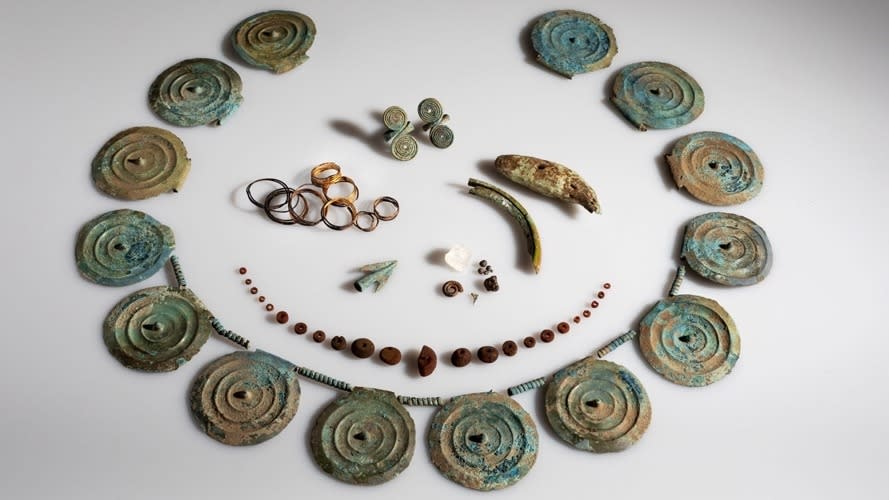Stash of 'eye-catching' Bronze Age jewelry discovered by metal detectorist in Swiss carrot field

A metal detectorist in Switzerland has unearthed a bounty of Bronze Age jewelry alongside fossilized animal remains in a farmer's freshly plowed carrot field.
Franz Zahn made the discovery in August while clearing scrap metal for the unnamed farmer in the northeastern town of Güttingen, according to a translated statement.
The finds included a necklace made up of 14 spiked bronze discs, two spiral finger rings and more than 100 tiny amber beads roughly the size of pinheads, which Zahn carefully plucked from the soil using tweezers. Other items strewn about the field, likely due to plowing, included a bronze arrowhead, lumps of polished ore, an ammonite (a type of extinct marine mollusk), a shark's tooth, a perforated bear's tooth and a rock crystal.
After finding the artifacts, Zahn contacted the local Office of Archaeology to survey the field's contents more extensively. Archaeologists determined that the jewelry items were "typical costume jewelry" that would've been worn by women in around 1500 B.C. during the Bronze Age.
Related: 'Very rare' Bronze Age arrow with quartzite tip uncovered in melting ice after 3,000 years
The archaeologists described the spiked discs as especially "eye-catching" and noted that metal spirals were strung between each disc as spacers. Each disc also had a narrow hole, making it easy to string them with a piece of thread or leather to wear as an adornment.
RELATED STORIES
—'Eye-catching' gold hair ring and Britain's oldest wooden comb found in Bronze Age burial
—'Gold find of the century': Metal detectorist in Norway discovers massive cache of jewelry
Archaeologists didn't unearth any human remains, but they think that the items were buried at the site inside either a sack or another type of organic container that has since decayed. Regardless of how they were buried, researchers think the items would've been special to the wearer and may have been viewed as having a protective or healing effect similar to an amulet.
A previous archaeological find in Güttingen several years ago revealed a Bronze Age pile-dwelling village that contained the remains of structures built on stilts, which dates to around 1000 B.C.
The newfound artifacts are currently being restored and will be exhibited at the Museum of Archeology in Frauenfeld next year.

